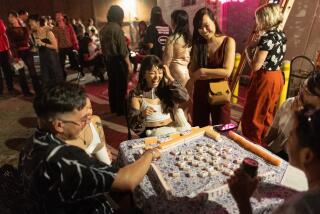Capturing the Mystery and Magic of Hong Kong
- Share via
“Don’t ever turn a fish over when you eat it,” warned Joana Sang as we drove past a dock lined with sampans on our way to the Chinese border. “It means you are turning a boat over somewhere.
“And remember that the number 4 is as unlucky in Hong Kong as 13 is for you Westerners,” she said. “Of course, 13 is unlucky here, too.”
Superstitions, ancestor worship, astrology, numerology, ghosts, dragons, auspicious seasons and days and hours--all are part of the complex and mysterious puzzle that is Hong Kong.
What you see, as a short-stay traveler, is just the shining surface, the end result. But in corporate suites, bank towers, luxury hotels, Buddhist temples and festival planning meetings, major decisions and matters of scheduling often involve consultation with wizards.
A veteran guide, Sang served up intriguing bits of fact and lore during our six-hour bus tour through the New Territories, that rural landscape of hills and forests, banana plantations and bamboo groves, terraced rice paddies and vegetable farms that spread over the 15 miles between bustling Hong Kong harbor and the southern border of China.
This is Hong Kong without neon or computers or noise, a Hong Kong that walks slowly and carries a joss stick. Its merchants tote sums on an abacus and shy away from cameras. Its children look up from school picnics, still curious about tall, blue-eyed visitors.
But no more curious, I suspect, than Western visitors are about the tales told by Sang.
“First, you must understand fung shui ,” she said as we began climbing 3,000-foot Tai Mo Shan, Hong Kong’s highest peak.
“Literally it means ‘wind and water,’ but it has to do with the proper placement of buildings in relation to the land--a mix of practical advice and mysticism to get just the right balance with nature. Bad fung shui means bad luck, even business failure.”
There are fung shui experts who come onto a construction site to divine the best position for a building--or even into an office or home to arrange a desk or chair. The belief in fung shui is so strong in Hong Kong that certified practitioners can demand a high price for their advice on siting and design.
“It’s best to line up a building with a hill behind and water in front,” said Sang. “The windows and doors should be arranged so that good spirits can get in and bad ones cannot.”
As our bus passed a government housing project, she told us to look at the top of each balcony. “See the mirrors? This site has bad fung shui , but the government had to build here anyway. And housing is too precious to turn down. So what you do is get a baht gwa , or eight-sided mirror, to reflect and frighten off evil spirits so they can’t get in your home.”
The Canton-born architect, Ieoh Ming Pei (known to the world as I.M. Pei), even made design concessions to fung shui in his dramatic yet strangely elusive, 70-story glass sculpture that houses the Hong Kong branch of the Bank of China. And the topping-out ceremony for the bank--the tallest building outside the United States--was arranged for Aug. 8, 1988, which fung shui experts called the most propitious date of the century.
“Eight is such a fortuitous number that in 1988, a man paid $5 million to get car license plate No. 8,” said Mrs. Sang as we parked near the old country market in Luen Wo. “There are lotteries for licenses with the numbers 7, 11 and 15, which are lucky, too.”
Within the shadowy market were tables of dried fish, coops of live chickens and heaps of fresh cabbages and sweet peppers. Men with wispy white beards and black skull caps sat on crates and smoked thin pipes.
One elderly shopkeeper sold only paper goods: notebooks, children’s party hats, toilet paper and millions of dollars in paper money marked “Bank of Hell,” a traditional funeral offering. No English was spoken. Prices were negotiated with raised fingers. Calculations were on the black beads of an abacus.
I paid the equivalent of $1 for a small octagonal spirit mirror, rimmed in red and green wood. I ended up giving it to a Hong Kong newsstand clerk, who asked if I knew which direction to hang it so that I would not accidentally keep the good spirits out of my home.
Beyond a heron and egret sanctuary--not far from the Chinese border--we stopped to visit a duck farm, a ring of placid ponds where fat white ducks glided through water lilies. It could have been a painting from an ancient silk-screen.
“Ducks have a 55-day life span in Hong Kong,” interjected Sang. “We eat a lot of duck and we like them young and tender.”
I recalled with pleasure the crisp Peking duck that is the specialty at the Spring Deer restaurant on Mody Road in Kowloon . . . although the moment was decidedly inauspicious.
More to Read
Sign up for The Wild
We’ll help you find the best places to hike, bike and run, as well as the perfect silent spots for meditation and yoga.
You may occasionally receive promotional content from the Los Angeles Times.






